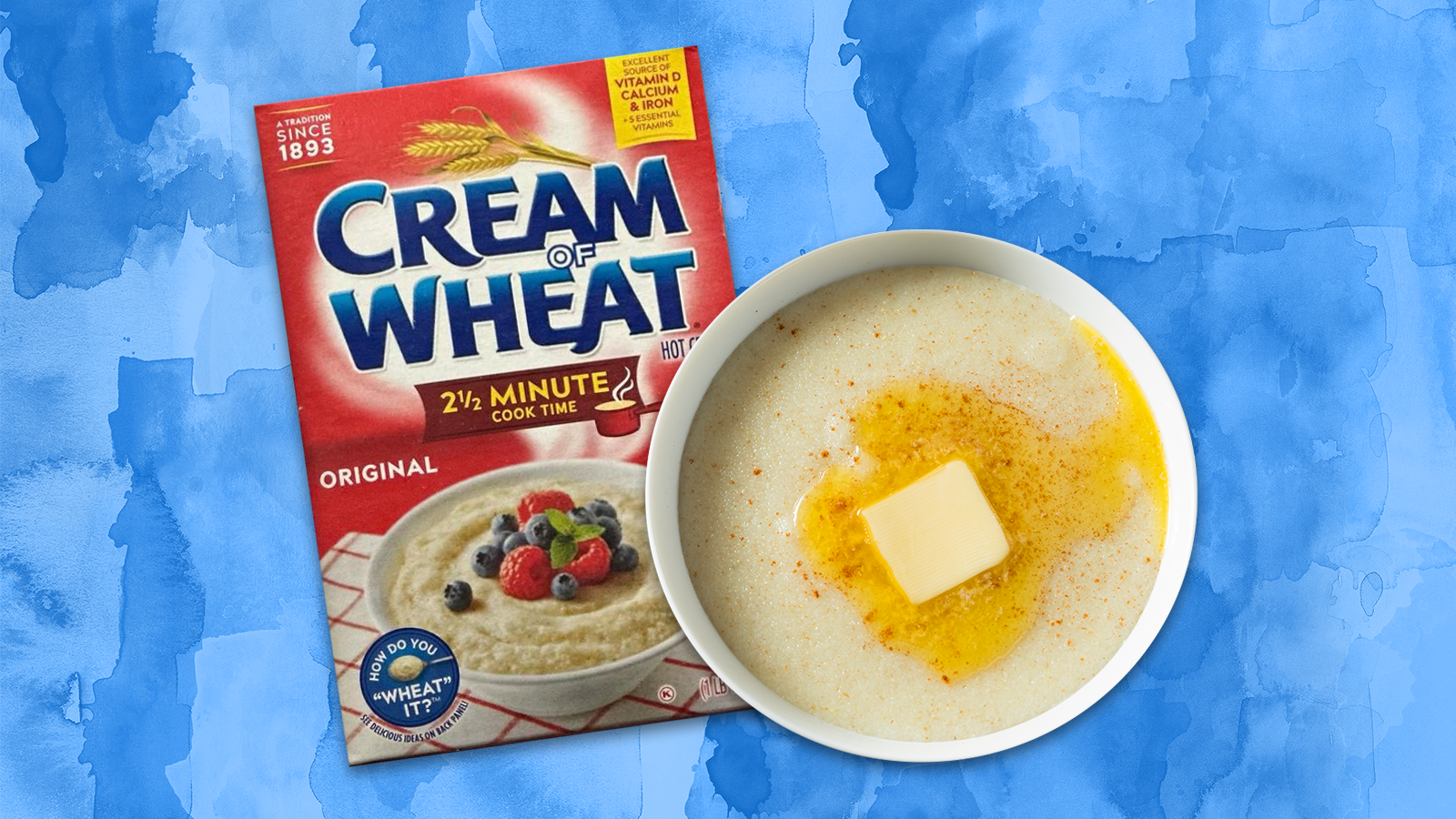Before shakshuka and bagels and lox ruled the Jewish breakfast landscape, there was the humble bowl of farina. Generally referred to as Cream of Wheat (due to the first company to mass-produce it in North America), it is a porridge made from the endosperm of the wheat grain. Farina is made by removing the bran from the endosperm. The endosperm (just a gross botany word for the food part of the seed) makes up the bulk of the grain, and is where we get pasta from.
According to many historians, farina originated in ancient civilizations like Egypt and Mesopotamia. There, it was adopted by Jews into their cuisine in a variety of ways, namely, as a creamy, mellow and slightly sweet porridge that was cheap and nourishing.
The word farina originates from the Latin word for “meal” or “flour.” In Eastern European Jewish cuisine, farina was generally served sweet and often to the very young and very old due to its soft consistency. It’s typically topped with brown sugar, fruit and nuts to add flavor. Even though breakfast was rarely an option for most working-class European Jews, it still made its way to the menus of many with little children and aging grandparents.
On the other side of the globe, as more and more Ashkenazi Jews began to immigrate to America, bringing with them their age-old recipes, Americans started to develop a taste for the creamy porridge.
The Nosher celebrates the traditions and recipes that have brought Jews together for centuries. Donate today to keep The Nosher's stories and recipes accessible to all.
The Rise of Farina
Cream of Wheat was first produced at a small flour mill in Grand Forks, North Dakota, in 1893. Since it was so similar to grits and oatmeal, it faced tough competition to become America’s breakfast of choice.
It was Cream of Wheat’s carb-heavy and nourishing qualities, and simple cooking instructions, that made it a hit for blue-collar Americans on the way to work. It didn’t take long for it to become one of the most prominent breakfasts on the market, with many other food companies attempting to capitalize on Cream of Wheat’s success.
My father introduced me to farina, which he explained was his favorite comfort food as a child.
“For me,” he explained, “farina was the ultimate comfort food. My bubba [sic] used to make it for me for breakfast, and I always prized the ‘lumps’ — those round, undercooked balls of farina that would be a little chewy and so delicious. It was like finding a prize at the bottom of a Cracker Jack box. It always felt like my bubba made those lumps just for me, and I can’t eat farina or any hot breakfast cereal without thinking that no one made it any better than she did.”
The Fall of Farina
In the second half of the 20th century, the tides shifted. With health being more of a focus, healthy breakfasts like acai bowls and yogurt started to be in vogue. Even as farina boasted its health benefits like its high contents of iron, niacin, vitamin B6, thiamine and riboflavin, it wasn’t enough to keep up.
Another factor that led to Cream of Wheat losing popularity was that, alongside many other commercial foods (such as Aunt Jemima and Uncle Ben) at the time, CoW had a problematic African-American spokesperson: Rastus. First introduced in 1893, the mascot was shown as a jolly and illiterate fool who commonly appeared in blackface minstrel shows from the late 19th and early 20th centuries.
The New York Times described Rastus as closer to a caricature than a real person, which reinforced contemporary racial prejudices. He was changed to Frank L. White, a Chicago chef, in the mid-1920s and, finally, in 2020, the mascot was done away with altogether after years of backlash and petitions.
Despite some attempts to bring farina into the 21st century, with new modern preparations looking to savory flavors, like butter, hot sauce and sauteed vegetables, nowadays, many young people don’t even know what farina is and can hardly tell it apart from other breakfast porridges. In global Jewish cuisine, however, farina never went out of style.
Farina In Jewish Food
Mizrahi Jews use farina in both savory dishes, like kubbeh and kibbeh, and in sweet treats like semolina cookies. In fact, in North Africa and the Middle East, almost all puddings and pastries are made from farina, like makroud, a cookie filled with dates, and tishpishti, a Sephardi honey-almond cake.
In Greek Jewish communities, it’s common to enjoy galaktoboureko — phyllo dough filled with a semolina custard — on Shavuot because of its resemblance to the stone tablets Moses formed on Mount Sinai. Farina halva, an alternative to the Middle Eastern tahini-based sweet, is commonly served in Baghdadi Jewish communities at Hanukkah parties, due to the fact the grain is cooked in oil when making the halva.
While few foods stay prevalent forever, Cream of Wheat remains a nostalgic comfort food for many North Americans. Meanwhile, Jewish kitchens around the globe continue to celebrate the versatility of farina, proving that this simple grain has so much more to give.



